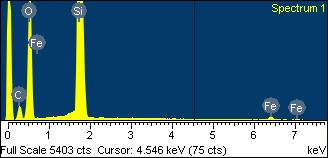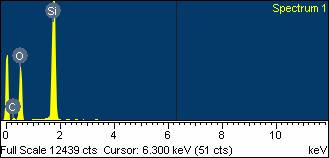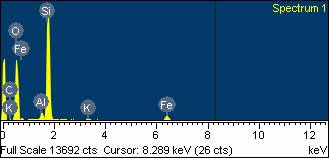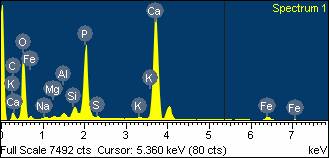



Chris Stringer is a Merit Researcher on hominids in the Department of Palaeontology at the Natural History Museum, London.Jack Cuozzo is the author of Buried Alive: the startling truth about Neanderthal Man.
See also:
Creationist Jack Cuozzo, in a debate with anthropologist Alan Man in April, claimed to have discovered two new human fossils at the site of the Swanscombe Man fossil in England. The claimed fossils were forwarded to Dr. Chris Stringer of London's Natural History Museum for examination, who wrote this response.
To investigate this further, on June 7th 2001 they were subjected to non-destructive Energy Dispersive X-ray (EDX) Spectrometry in the Mineralogy Department, in comparison with gravel and genuine fossil bone from Swanscombe. Sample 1 is claimed by Cuozzo to be a left mastoid process from the Swanscombe skull, and sample 2 is supposedly the pubic bone from the skeleton. For comparison, sample 3 is a piece of siliceous gravel from the Middle Gravels at Swanscombe, which contained the human skull, and sample 4 is a Bison phalanx from the Middle Gravels. Unfortunately, the actual fossil human bones from Swanscombe were too large to enter the EDX analytical chamber, but their preservation is consistent with the other Swanscombe fossils and also unlike Dr Cuozzo's specimens. Representative results of the analyses are attached as jpeg files. As can be seen, Dr Cuozzo's finds display the characteristic spectra of siliceous rocks (note the Silicon and Oxygen peaks), and do not display the peaks for Calcium and Phosphorus found in the genuine Swanscombe fossil bone.
| Energy Dispersive X-ray Spectrometry Test Results | |
|---|---|
| Sample 1: claimed by Cuozzo to be left mastoid process of the Swanscombe skull |

|
| Sample 2: claimed by Cuozzo to be human pubic bone |

|
| Sample 3: a piece of siliceous gravel from the Middle Gravels at Swanscombe |

|
| Sample 4: Bison phalanx from the Middle Gravels |

|
Once it was established that these were pieces of siliceous gravel, they were thin-sectioned, further demonstrating that their internal structure is entirely mineralogical, lacking the microstructure of bone. I attach images of the Swanscombe "bones" and sections. They are figure 005 "mastoid", 004 sectioned "mastoid", 003 "pubis", 002 sectioned "pubis". For comparison I attach three figures showing the actual Swanscombe left parietal, which Dr Cuozzo's "mastoid" supposedly fits (Dscn501,502,504). Colour, texture and preservation can be seen to be completely different, as would be expected from the EDX results. To summarise, Dr Cuozzo's Swanscombe "bones" can be shown by observation, analysis and sectioning to be pieces of siliceous gravel, and this should have been apparent to him if he had conducted even a cursory comparison of these pieces with actual mammalian fossils from the site.
I have returned this material to Dr Cuozzo, via Mr Paul Humber, but I will retain the thin sections in case there are accusations that I have falsified the data. I have also, via Mr Humber, extended an invitation for Dr Cuozzo to make his own comparisons with genuine Swanscombe fossil material in our collections. I would like to thank my colleagues in Mineralogy, John Spratt, Terry Greenwood, Terry Williams and Tony Wighton, for their assistance with these analyses, and Professor Christopher Dean and the NHM Photographic Unit for photographic work.
Regarding "missing bone" from the left mastoid process, apparently also considered suspicious by Dr Cuozzo, this area has been described, photographed, radiographed, scanned and replicated on various occasions since the discovery in 1921 (see, for example, Montgomery, P.Q., Williams, H.O.L., Reading, N. and Stringer, C.B. 1994. An Assessment of the Temporal Bone Lesions of the Broken Hill Cranium. Journal of Archaeological Science, 21:331-337). Again, all of the relevant material is available for scientific examination here. I wish Dr Cuozzo had checked properly before publishing unwarranted allegations about this Museum and its staff, and I hope he will correct them now that more accurate information is available.
I got involved in the saga of Dr Cuozzo and Swanscombe because he claimed to have found more of the skeleton of the Pleistocene Swanscombe human, which is curated here: to quote from his website: "Dr. Jack Cuozzo, author of the book "Buried Alive - The Startling Truth about Neanderthal Man" discovered 2 additional pieces of the Swanscombe woman in September 2000". However, as the preservation of his material is demonstrably completely different from those of Pleistocene fossils from Swanscombe, including the human cranial bones, I see no reason to alter my view that he has not found more parts of the Swanscombe human. Moreover, my colleague Dr John Whittaker, one of the world's leading micropalaeontologists, informs me that the fossil within the "mastoid" gravel section is definitely a foraminifer, showing the proloculus, spire, septa and chambers, not (as claimed by Dr Cuozzo) a larva of Trichinella spiralis. However, he could not make a more precise identification without studying the original specimen. It is, of course, quite impossible for a human bone, however fossilised, to incorporate a fossil foram. I have invited Dr Cuozzo to come to London and make his own comparisons. Otherwise I am more than happy to leave him to continue his own research into the constitution of the Swanscombe gravels.
Chris Stringer, Dept. of Palaeontology, The Natural History Museum, London
http://www.nhm.ac.uk/research-curation/staff-directory/palaeontology/cv-5508.html
This page is part of the Fossil Hominids FAQ at the talk.origins Archive.
Home Page |
Species |
Fossils |
Creationism |
Reading |
References
Illustrations |
What's New |
Feedback |
Search |
Links |
Fiction
http://www.talkorigins.org/faqs/homs/stringer.html, 01/31/2002
Copyright © Jim Foley
|| Email me 